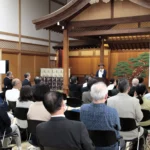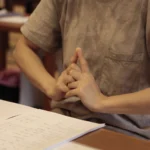Message for Love, Peace and Hope
By Bill Roberts
Konbanwa. Bill Roberts des. Yoroshiku.
It is an honor to speak today as we begin this Grand Festival of Setsubun. I have visited Oomoto several times and I have heard many stories about Setsubun but this is the first time I have attended the festival. I look forward to witnessing this important annual purification ritual.
The timing of my attendance at Setsubun seems appropriate given the reason I am at Oomoto now and given where the world, especially my own country, seems to be at this point in history.
As some of you know, I am here for a year to write a book about Oomoto. I will tell you more about the book in a few minutes. For now, let me just say that in my previous visits to Oomoto I have had many experiences that will help me write this book, but I have never experienced Setsubun. And how could anyone write a credible book about Oomoto without attending Setsubun?
As I understand it, Setsubun means many things that are important to the Oomoto story. It means the changing of the seasons, from winter to spring, which is a time to ask for blessings for the coming year. It means a grand purification of the nation, the universe and our own souls, as we seek to rid ourselves of sin.
Last but not least, Setsubun marks –with great rejoicing– the day that Ushitora no Konjin first revealed his divine presence through the Foundress, Nao Deguchi, and proclaimed his effort to reconstruct the Greater World and bring peace on earth.
The words of Ushitora no Konjin, delivered through Nao Deguchi, are more than 100 years old. And world peace, disarmament and the folly of war are continuous themes in the Oomoto story, especially in the teachings of Co-Founder Onisaburo Deguchi.
All of these ideas seem just as important today as they were a century ago. Perhaps that’s because there are some disturbing parallels between America today and the Japan of Onisaburo’s time.
For example, Onisaburo once stated that Shinto had been misused for political goals. In America, certain politicians use their Christian faith to justify domestic policies that are really driven by greed, and foreign policies that are actually driven by fear and vengeance.
We already see the disastrous results of these policies: A widening gap between rich and poor, the declining environment and –at the top of the list– the continuing death and destruction in Iraq.
Here’s another parallel between Japan then and America now. Just as Onisaburo and many Japanese opposed imperial policies, as many as half of Americans today oppose current U.S. policies.
I fear that America, like imperial Japan, may have to pay a steep price for its arrogance and aggression. I do not know how or when. Unlike Onisaburo I am not a prophet.
I hope I have not offended anyone by talking about politics. My intention is to illustrate how relevant Oomoto’s teachings are in today’s world.
The broader message Oomoto offers is a message of peace, love and hope. Oomoto’s commitment to art and interfaith efforts—these are just some of the ways to help achieve peace, love and hope. It is impossible to make war and make art at the same time.
This brings me to the book I am writing.
Thirty years ago Frederick Franck, an author, artist and physician, wrote “An Encounter With Oomoto,” the last book written in English about Oomoto. This fine book is still in print but much has happened in 30 years and many people at Oomoto think it is time for someone to take a fresh look.
So, the Oomoto Foundation commissioned me to write a book in English to explain Oomoto to a non-Japanese audience, especially the artists and interfaith activists who are attracted to Oomoto for somewhat different reasons.
Many artists in the West are intrigued when they first hear about a Shinto sect that uses the arts as part of its spiritual practice. And they are eager to learn more when they hear about the multi-talented Onisaburo Deguchi who preached that the value of art is the process of doing it, not the final product.
Onisaburo wrote: “Art is not the preserve of the specialist, but a Way for every ordinary human being to himself and to God.” In the West, increasingly more artists would agree with that.
The Oomoto teaching that attracts another audience is the belief that all gods are one god and all religions come from the same great origin. The implication of this teaching is the need for religious tolerance, which is in short supply just now. But there are many ecumenically minded people in all religions attracted to Oomoto’s interfaith activities because of its message of tolerance.
Most non-Japanese first encounter Oomoto through the arts or through interfaith activities. These people are the primary audience for this new book.
Personally, I first encountered Oomoto through the arts, specifically Onisaburo Deguchi’s tea bowls. I earn my living as a freelance journalist in Silicon Valley, California, where I write about technology and business for various magazines. In 1998 I began to study ceramics as a hobby with Coeleen Kiebert, an artist and teacher in my part of California. Coeleen attended Oomoto’s traditional Japanese arts seminar in 1985.
One day Coeleen said she would take a group of students to Oomoto to study the Japanese arts in the spring of 1999. She talked about Onisaburo Deguchi and showed us pictures of his tea bowls. I was captivated by the spirit of Onisaburo’s yowan. I signed up for the trip and by the end of that visit I was enthralled with Japan, especially its scenery, culture and arts. I was also touched by Oomoto’s friendliness and hospitality.
After that first trip I was surprised at how much I liked Japan. In retrospect I should not have been surprised at all. You see, my parents met in Japan after World War II. My father was a career Army officer and my mother was a civilian secretary for the Army. They were married in Tokyo in 1947.
I was conceived in Japan in April 1949 about three months before my parents returned to the United States, where I was born. So my first trip to Japan was exactly 50 years after I was conceived here, which makes Japan a special place for me. But I had to come here that first time to understand this and to feel it in my heart.
I returned to Japan with Coeleen in the spring of 2000 and in the spring of 2001. Because of my growing interest in Oomoto and my writing skills, the Oomoto International Department then invited me to work on several editorial projects.
I first came as a volunteer for three months in late 2001. I returned in 2002 and 2003 for other volunteer writing assignments. Most of the stories I wrote and the photos I took during these visits were for the English section of the Oomoto home page.
On this current trip, I arrived in October and plan to stay about a year to write this book. I did quite a bit of research on my previous visits but I have more interviews to conduct. And I also wanted to experience Setsubun before I began to write in earnest.
Oomoto offers an important message to artists, religious people and peace seekers everywhere. Oomoto is a beacon in a darkening world, offering a message people desperately need to hear during these dangerous times. I hope my book will in some small way help to convey this message to people outside Japan.
It is the message of peace, love and hope.
It is the wisdom of Nao and Onisaburo Deguchi.
And it is the message we proclaim today by celebrating Setsubun.
Kyo-wa watashino hanashi-o. O-kiki kudasari. Arrigato gozaimashta.



